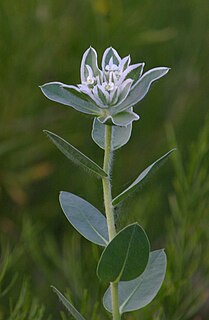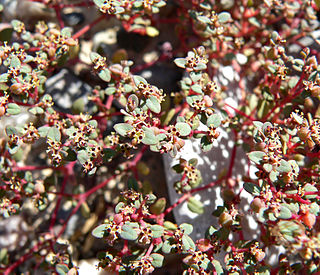
Euphorbia is a very large and diverse genus of flowering plants, commonly called spurge, in the spurge family (Euphorbiaceae). "Euphorbia" is sometimes used in ordinary English to collectively refer to all members of Euphorbiaceae, not just to members of the genus. Some euphorbias are commercially widely available, such as poinsettias at Christmas. Some are commonly cultivated as ornamentals, or collected and highly valued for the aesthetic appearance of their unique floral structures, such as the crown of thorns plant. Euphorbias from the deserts of Southern Africa and Madagascar have evolved physical characteristics and forms similar to cacti of North and South America, so they are often incorrectly referred to as cacti. Some are used as ornamentals in landscaping, because of beautiful or striking overall forms, and drought and heat tolerance.

Euphorbia mellifera, the Canary spurge or honey spurge, is a species of flowering plant in the spurge family Euphorbiaceae, native to Madeira and the Canary Islands. It is an evergreen shrub growing to 2 m or more, with narrow leaves up to 20 cm (8 in) long. In spring it produces brown, honey-scented flowers.
Susan Carter Holmes is a botanist and taxonomist at the Royal Botanic Gardens, Kew. She discovered and catalogued more than 200 plants of the family Euphorbiaceae, particularly of the succulent East African members of the genera Euphorbia and Monadenium, as well as about 20 Aloe species. All plants and articles are published under her maiden-name Susan Carter.

Euphorbia abdelkuri is a species of plant in the family Euphorbiaceae. It is endemic to Abd al Kuri, an island south of Yemen. Its natural habitat is rocky areas. The Latex of the plant is toxic.

Euphorbia arbuscula is a species of plant in the spurge family (Euphorbiaceae). It is endemic to the archipelago of Socotra in Yemen. Its natural habitats are subtropical or tropical dry forests and subtropical or tropical dry shrubland.
Euphorbia obcordata is a species of plant in the family Euphorbiaceae. It is endemic to Yemen. Its natural habitats are subtropical or tropical dry forests and rocky areas.
Euphorbia quitensis is a species of plant in the family Euphorbiaceae. It is endemic to Ecuador. Its natural habitat is subtropical or tropical moist montane forests.

Euphorbia socotrana is a species of plant in the family Euphorbiaceae. It is endemic to Yemen. Its natural habitats are subtropical or tropical dry forests and subtropical or tropical dry shrubland.

Euphorbia spiralis is a species of plant in the family Euphorbiaceae. It is endemic to Yemen.

The Euphorbiaceae, the spurge family, are a large family of flowering plants. In common English, they are sometimes called euphorbias, which is also the name of a genus in the family. Most spurges such as Euphorbia paralias are herbs, but some, especially in the tropics, are shrubs or trees, such as Hevea brasiliensis. Some, such as Euphorbia canariensis, are succulent and resemble cacti because of convergent evolution. This family occurs mainly in the tropics, with the majority of the species in the Indo-Malayan region and tropical America a strong second. A large variety occurs in tropical Africa, but they are not as abundant or varied as in the two other tropical regions. However, the Euphorbiaceae also have many species in nontropical areas such as the Mediterranean Basin, the Middle East, South Africa, and the Southern United States.

Euphorbia paralias, the sea spurge, is a species of Euphorbia, native to Europe, northern Africa, and western Asia.

Euphorbia marginata is a small annual in the spurge family.

Euphorbia micromera is a species of flowering plant in the family Euphorbiaceae. It is known by the common name Sonoran sandmat. It is native to the southwestern United States from California to Texas, and northern Mexico, where it grows in sandy soils in desert and other dry habitat. It is an annual herb forming a small mat of slender stems. The hairy to hairless leaves are oblong in shape and just a few millimeters long. The tiny inflorescence is a cyathium less than a millimeter wide. It lacks the appendages that many similar species have in their cyathia. It has only a central female flower and 2 to 5 male flowers surrounded by round red nectar glands. The fruit is a minute round capsule.

Euphorbia hirta is a pantropical weed, originating from the tropical regions of the Americas. It is a hairy herb that grows in open grasslands, roadsides and pathways in the warmer regions of India and Australia as an introduced species. It is used in traditional herbal medicine.

Euphorbia caput-medusae is a plant of the genus Euphorbia that occurs in and around Cape Town, South Africa.
Euphorbia remyi is a rare species of flowering plant in the family Euphorbiaceae. It is known by the common name Remy's sandmat locally as ʻakoko. It is endemic to the island of Kauaʻi in Hawaii, where it grows in mixed mesic forests, wet forests and bogs from 150 to 900 m.

The North-West University Botanical Garden on the Potchefstroom Campus of the North-West University (NWU) is the only botanical garden in the North West Province of South Africa. The Garden spans just under three hectares and is open to the public.

Euphorbia clavarioides is a species of herbaceous plant in the family Euphorbiaceae. It is native to Botswana, Lesotho, and South Africa. It may grow to 18 cm in diameter, with a height of 30 cm. Its flowers are yellow.

Euphorbia davidii, known as David's spurge or toothed spurge, is a species of flowering plant in the spurge family Euphorbiaceae.

World Flora Online is an Internet-based compendium of the world’s plant species.















